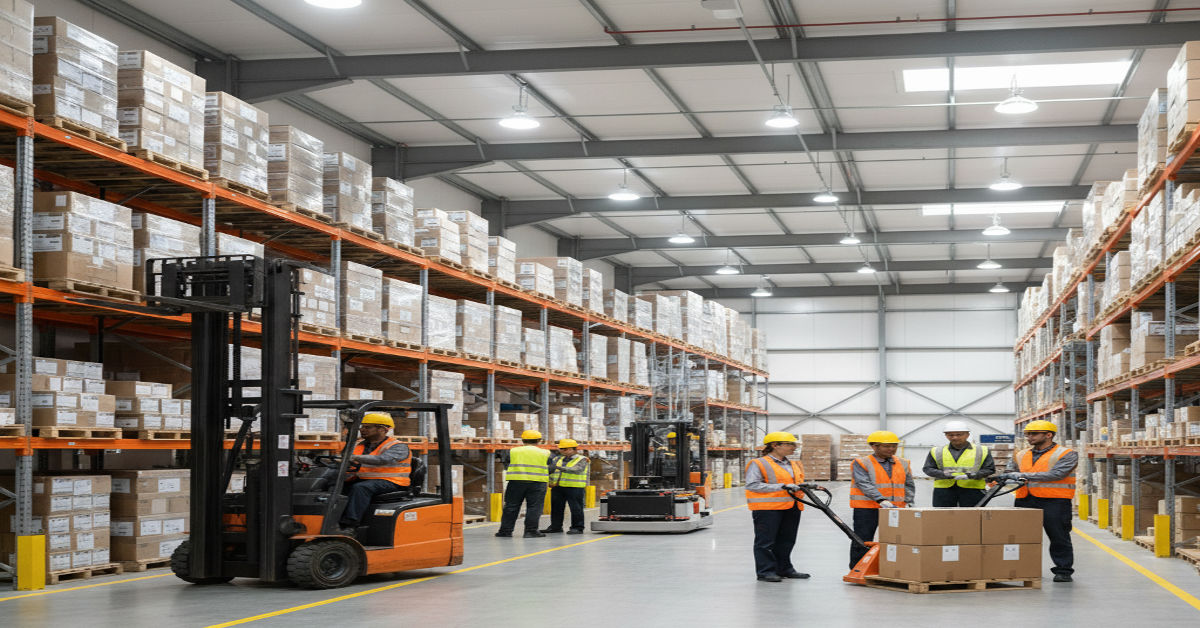In the ever-evolving world of logistics, manufacturing, warehousing, and distribution, efficiency is more than a competitive advantage—it is a necessity. One of the most influential factors contributing to operational efficiency is the effective use of Material Handling Equipment. These machines and tools not only streamline movement, storage, control, and protection of materials, but also minimize human effort, reduce workplace injuries, and ensure smooth, uninterrupted workflow.In this comprehensive guide, we will explore the types, benefits, challenges, selection criteria, and future trends of material handling solutions. Whether you’re building a new facility or optimizing existing operations, understanding the right use of Material Handling Equipment can significantly enhance your organizational performance.
Understanding Material Handling Equipment
Material Handling Equipment refers to the mechanical equipment involved in the complete system of movement, storage, protection, and control of materials and products throughout the manufacturing, warehousing, distribution, consumption, and disposal stages.
Broadly, this equipment can be grouped into four main categories:
- Storage and Handling Equipment
- Industrial Trucks
- Engineered Systems
- Bulk Material Handling Equipment
Each of these categories is designed to fulfill specific functions within the supply chain and has its own advantages, limitations, and best-use scenarios.
1. Storage and Handling Equipment
These are typically non-automated equipment used to store materials safely until they are needed for processing, transportation, or sale. Some examples include:
- Pallets and Skids: Used for stacking and storing goods.
- Shelving and Racks: Ideal for organizing inventory and improving retrieval times.
- Bins and Drawers: Designed for smaller, loose materials.
Stacking Frames: Provide vertical storage without compromising safety.
Storage systems allow businesses to maximize space utilization, maintain inventory
accuracy, and reduce the time spent locating items. Effective use of storage equipment directly affects picking speeds and order accuracy.
2. Industrial Trucks
This category includes equipment used to transport materials over variable distances. Trucks can be either manually operated or motorized and are an essential part of internal logistics. Examples include:
- Forklifts: Used for lifting and transporting pallets.
- Pallet Jacks: Ideal for short-distance, manual transport.
- Order Pickers: Help retrieve items from warehouse shelves.
- Side Loaders and Walkie Stackers: Used for maneuvering in narrow aisles or confined spaces.
Industrial trucks are the lifeblood of most warehouses and production facilities. They improve workflow, reduce manual labor, and minimize the risk of material damage.
3. Engineered Systems
These are highly automated systems used for bulk storage, retrieval, and movement. Typically, they are custom-designed and integrated with software for intelligent management. Some key examples include:
- Automated Storage and Retrieval Systems (AS/RS): Robotics-based systems for retrieving goods from designated storage locations.
- Conveyor Systems: Transport materials in a continuous loop or along fixed paths.
- Automated Guided Vehicles (AGVs): Mobile robots that follow predefined paths using sensors or markers.
- Sortation Systems: Automatically sort products based on size, destination, or other criteria.
Engineered systems are expensive to install and maintain but offer unmatched efficiency, accuracy, and scalability. They are best suited for high-volume, high-speed environments like e-commerce warehouses and large manufacturing plants.
4. Bulk Material Handling Equipment
This type of equipment is used for managing bulk goods—loose, granular, or powdered materials. These tools often support the movement, measurement, and control of bulk materials in large volumes. Examples include:
- Conveyor Belts and Bucket Elevators
- Hoppers and Silos
- Stackers and Reclaimers
- Screw and Vibrating Conveyors
Industries like agriculture, mining, construction, and food processing rely heavily on this category of equipment for moving sand, gravel, grains, cement, chemicals, or food ingredients.
The Benefits of Using the Right Material Handling Equipment
Implementing appropriate Material Handling Equipment within your operations provides a wide range of organizational benefits:
1. Increased Productivity
By automating or streamlining the movement of goods, you minimize manual effort, reduce cycle times, and ensure faster turnaround. The result is improved throughput and fulfillment speeds.
2. Improved Safety
Manual handling is one of the leading causes of workplace injuries. With the right equipment, the risk of slips, strains, and accidents is drastically reduced. This not only protects employees but also lowers insurance and compensation costs.
3. Better Space Utilization
Efficient storage systems and mobile handling equipment allow for vertical expansion and strategic organization, making better use of available square footage.
4. Enhanced Inventory Control
When integrated with inventory management systems, handling equipment can provide real-time tracking, reducing losses from misplaced goods, overstocking, or stockouts.
5. Lower Operational Costs
Although material handling equipment often requires upfront investment, it yields long-term savings through reduced labor, less material waste, and faster order processing.
How to Choose the Right Equipment
Selecting the appropriate material handling solution involves careful evaluation. Here’s a strategic process you can follow:
1. Analyze Your Operational Needs
Begin by identifying what materials you handle, their volume, weight, size, frequency of movement, and distance between locations. Also, consider environmental factors like space constraints, aisle widths, and temperature control.
2. Define Your Budget
Factor in not only the equipment’s purchase price but also installation, training, maintenance, and potential upgrades. Sometimes, renting or leasing equipment may be more practical for short-term or fluctuating demands.
3. Evaluate Integration Capabilities
If you’re already using warehouse management software or enterprise resource planning (ERP) systems, ensure your equipment can integrate smoothly to allow automation and real-time data collection.
4. Prioritize Ergonomics and Safety
Your equipment must be designed to reduce physical strain and comply with local safety standards. Look for features like automatic shutoff, guardrails, low vibration levels, and clear operator visibility.
5. Future-Proofing
Consider not only your current needs but also potential growth. Choose scalable systems or equipment that can be easily upgraded or reconfigured to meet future demands.
Common Challenges in Material Handling
Even the best equipment can fall short without proper planning and management. Here are some challenges to be aware of:
1. Inadequate Training
Even the most advanced systems require skilled operators. Insufficient training can lead to equipment misuse, inefficiencies, and safety risks.
2. Poor Maintenance
Lack of regular inspection, servicing, and calibration can result in unplanned downtime, reduced lifespan, and increased costs.
3. Underestimating Complexity
Some operations implement equipment without fully assessing compatibility, leading to bottlenecks or underutilization. A full workflow analysis should precede equipment purchase or installation.
4. Overdependence on Manual Labor
Relying too heavily on manual processes increases the chances of human error and limits scalability. A balanced approach between automation and human oversight is ideal.
Emerging Trends in Material Handling
The world of material handling is undergoing rapid transformation thanks to technological innovation. Here are some key trends shaping the future:
1. Smart Equipment
The integration of sensors, IoT, and AI is making material handling equipment smarter. Systems can now self-diagnose issues, monitor usage patterns, and adjust operations in real-time to optimize performance.
2. Robotics and Automation
Autonomous mobile robots (AMRs) and robotic arms are revolutionizing tasks like picking, sorting, and transporting. These machines operate 24/7 with high accuracy and minimal supervision.
3. Green Equipment
Sustainability is becoming a priority. Battery-powered forklifts, energy-efficient conveyors, and recyclable material containers are reducing environmental impact while cutting long-term costs.
4. Modular Systems
Businesses are turning to modular racking, shelving, and conveyor systems that can be easily reconfigured. This flexibility supports rapid changes in product lines or seasonal demands.
5. Augmented Reality (AR) & Wearables
AR goggles and smart gloves are being used to assist warehouse workers with pick-and-pack tasks. These tools improve speed, reduce errors, and make training easier.
Case Study: Streamlining Operations with Material Handling Equipment
Let’s consider a mid-sized e-commerce company facing high order volumes and inconsistent delivery times. Their primary issue was inefficient picking and packing processes.
Solution:
- Installed an Automated Storage and Retrieval System (AS/RS) for better inventory management.
- Replaced manual pallet jacks with electric forklifts.
- Implemented pick-to-light systems to reduce human error.
Results:
- Order fulfillment times dropped by 35%.
- Labor costs decreased by 20%.
- Workplace incidents fell by 50% due to reduced manual handling.
This example illustrates the tangible impact the right Material Handling Equipment can have on productivity, safety, and cost-efficiency.
Conclusion
In today’s competitive industrial and logistical landscape, effective material handling is more than a necessity—it’s a strategic asset. Businesses that invest wisely in material handling equipment enjoy streamlined operations, lower costs, higher safety standards, and greater adaptability.From understanding the various equipment categories to navigating selection criteria and embracing new trends, decision-makers must take a comprehensive approach. Whether you’re running a warehouse, managing a construction site, or operating a distribution center, the right equipment will help you move smarter, safer, and faster.If you’re ready to assess or upgrade your current systems, begin with a detailed workflow analysis and consult with experienced equipment providers. The long-term payoff—in productivity, safety, and savings—makes it an investment well worth considering.







